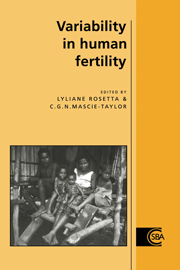Book contents
- Frontmatter
- Contents
- List of contributors
- 1 Introduction: the biological anthropological approach
- PART I HORMONAL ASPECTS OF FERTILITY REGULATION
- PART II INTERPOPULATION VARIABILITY
- PART III METABOLIC AND ENERGETIC ASPECTS OF REGULATION
- 8 Metabolic adaptation in humans: does it occur?
- 9 Possible adaptive mechanisms for energy saving during physical activity
- 10 Body composition and fertility: methodological considerations
- 11 Breast-feeding practices and other metabolic loads affecting human reproduction
- Index
9 - Possible adaptive mechanisms for energy saving during physical activity
Published online by Cambridge University Press: 03 February 2010
- Frontmatter
- Contents
- List of contributors
- 1 Introduction: the biological anthropological approach
- PART I HORMONAL ASPECTS OF FERTILITY REGULATION
- PART II INTERPOPULATION VARIABILITY
- PART III METABOLIC AND ENERGETIC ASPECTS OF REGULATION
- 8 Metabolic adaptation in humans: does it occur?
- 9 Possible adaptive mechanisms for energy saving during physical activity
- 10 Body composition and fertility: methodological considerations
- 11 Breast-feeding practices and other metabolic loads affecting human reproduction
- Index
Summary
There is considerable interest in knowing the possible mechanisms by which undernourished individuals are able to reduce their energy expenditure in response to limited energy intake. This knowledge is especially pertinent because about 20-25% of the population of the world are living in less-developing countries where food shortages exist. Many studies have attempted to evaluate the energy intake, the energy output and the work capacity of such populations in order to determine whether energy balance is maintained, and if so, by what adaptive mechanisms.
Several methods have been used but most of them are difficult to apply under field conditions. For instance, energy intake studies are usually completed by means of questionnaires or diet diaries filled in by the subjects themselves with the responses being checked by a nutritionist (Marr, 1971; Boisvert et al., 1988). part from problems of literacy which may make completion of forms difficult, accurate knowledge of the chemical composition and energetic equivalent of the ingested food must be known. This is not always easily obtainable in developing countries where the food is often very specific and original (Toury, Giorgi & Favier, 1967; FAO, 1968, 1972; Benefice et al., 1985; Rosetta, 1988).
In order to measure energy output, researchers have often had to rely on responses to questionnaires or diaries which record the amount and extent of physical activities of subjects (Bouchard et al., 1983). Many other methods are used too. For example, the continuous recording of heart rate (HR) throughout the day, can, knowing the linear relationship between HR and the oxygen consumption, be used to determine energy output (Bradfield, 1971; Rieu et al., 1980).
- Type
- Chapter
- Information
- Variability in Human Fertility , pp. 148 - 166Publisher: Cambridge University PressPrint publication year: 1996
- 2
- Cited by



